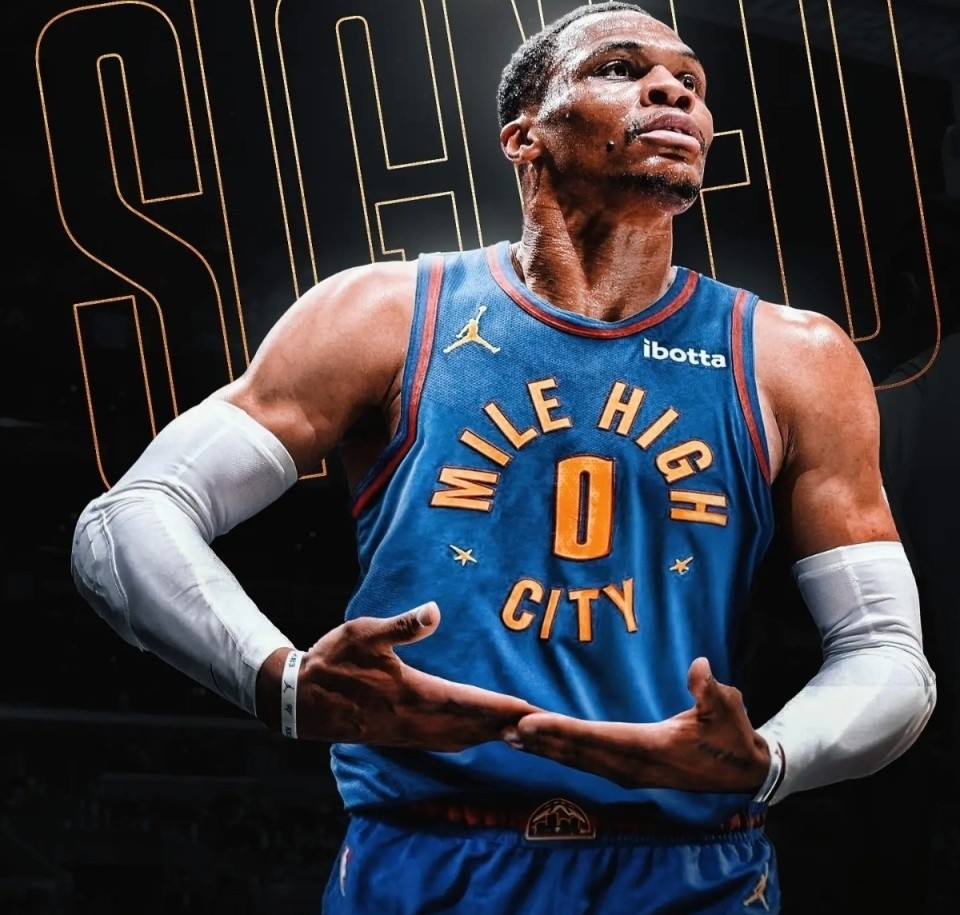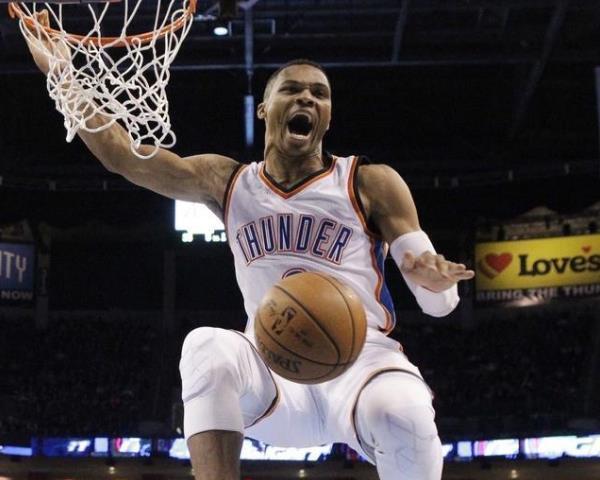In the NBA arena, Russell Westbrook has always been known for his powerful and dominant playing style. From his early days in the league, his lightning-fast breaks and passionate dunks were like surging tides, repeatedly attacking the opponent's defense and igniting the fans' enthusiasm. In those years, he often relied on his own strength to tear through the opponent's defense, single-handedly breaking into the paint, and scoring in the crowded restricted area, as if nothing could stop him.
Westbrook is also the astonishing "triple-double machine," seemingly omnipresent on the court. He could compete for rebounds under the basket with the big men inside, and complete steals with lightning speed, initiate fast breaks, and then deliver precise assists to his teammates, helping them score easily. He defines the concept of an all-around player with his skills, repeatedly setting triple-double records and becoming a unique landscape in the league.

However, this season, fans were surprised to find that this star, who has always had a tough and unique style, has quietly changed his approach! The once "ball-dominant" Westbrook now does more to set up his teammates on the court, willing to create opportunities for them, reducing his ball-handling solo play and increasing his off-ball movement and catch-and-shoot attempts. Such a significant change is like a cheetah suddenly retracting its claws and instead using its agility to cooperate with teammates in hunting, how can it not be surprising and curious? This change quickly sparked a wave of heated discussions among fans and the media, with everyone asking: What prompted Westbrook to make such a change? What impact will this change have on the team? Is it a self-driven breakthrough after experiencing the ups and downs of his career, a requirement of the team's tactical system, or other unknown reasons? And can this transformation lead him and the team to new heights?
Looking back at Westbrook's "ball-dominant" past, when he was with the Thunder, Westbrook was like a general on the battlefield, wielding heavy troops (ball rights) and maneuvering freely. His physical fitness is at a freakish level, with an explosive power that seems to make the floor tremble. His start is as fast as lightning, leaving defenders trailing behind. On the offensive end, he has a strong desire to attack, often dribbling solo and relying on his own strength to break through the opponent's defense. No matter if it's a solid wall or a tight siege ahead, he chooses to force his way through without hesitation, completing difficult finishing moves in mid-air with body contact, or shooting jump shots against the defender's block.

In the 2016-2017 season, Westbrook experienced a major outbreak in personal statistics, averaging 31.6 points, 10.7 rebounds, and 10.4 assists per game, achieving the remarkable feat of averaging a triple-double, becoming the second player in NBA history after Oscar Robertson to average a triple-double in a single season, and winning the regular-season MVP with his outstanding performance. In many games that season, he was the undisputed offensive core of the team, with the ball surely in his hands in critical moments, while his teammates mostly played the role of creating space and waiting to shoot.
For example, in a game against the Magic, Westbrook went completely red-eyed, taking a crazy 40 shots and making 21, scoring 57 points, 13 rebounds, and 11 assists in a super triple-double performance. He carried the team on his shoulders with his own strength, leading the Thunder through overtime to a hard-fought victory over their opponents with a score of 114-106. He used this almost "domineering" style to declare his strength and determination to the world. At that time, he was the symbol of the Thunder, the absolute protagonist on the court, controlling every rhythm of the game.

However, although this style brought him countless honors, it also attracted much controversy. Some fans and media criticized him for making too casual shot choices and being too obsessed with individual play, resulting in low offensive efficiency for the team. For example, in key matchups against some strong teams, when opponents targeted him with tight defense and cut off his connection with his teammates, Westbrook still insisted on personal attacks, causing the team's offense to often stall, affecting the overall win rate. In the series against the Warriors, the Warriors formulated a defensive strategy of "allowing shooting but not penetration" against Westbrook, luring him into outside shooting and reducing his penetration and passing, which greatly reduced Westbrook's offensive efficiency, and the team struggled to win in the series.
During the Nuggets period, Westbrook underwent a transformation. (1) The new environment brings new opportunities. This season, Westbrook joined the Denver Nuggets, which undoubtedly became a crucial turning point in his career. The Nuggets have a unique tactical system, and their core, Nikola Jokic, is a center with extremely high basketball IQ and an all-around playing style. Jokic is like a majestic mountain peak in the paint, with great dominance. His passing vision is extremely broad, as if he has eyes in the back of his head, able to accurately spot open teammates amidst tight defenses, and then deliver a well-timed pass to activate the team's offense. His style forces opponents to double-team him on defense, which in turn creates more offensive space for Westbrook.

The Nuggets' head coach, Michael Malone, is also a tactical master. He understands Westbrook's technical characteristics and potential energy, skillfully tailoring tactics for Westbrook. When Westbrook and Jokic are on the court together, Coach Malone arranges for Westbrook to do more off-ball movement, using Jokic's strong drawing power to create excellent opportunities for Westbrook to take open shots or cut to the basket. In pick-and-roll plays, Jokic's sturdy body is like a solid wall, blocking defenders for Westbrook, who can choose to use his speed advantage to break through the defense or return the ball to Jokic rolling down, with their cooperation like a sharp double-edged sword, making it difficult for opponents to defend.
(2) Data highlights the extent of change. Looking at the data, Westbrook's change is clear. In previous seasons, Westbrook's average touch time often reached more than 7 minutes, with 5-6 dribbles after each touch, acting like the engine of the team's offense, with most of the offense initiated by him. However, this season, his average touch time has significantly dropped to 3.88 seconds, with dribbles after each touch sharply reduced to 3.49 times. This means he no longer holds the ball for long periods, but makes decisions faster, passing the ball out, making the team's offensive rhythm smoother.

In terms of scoring methods, Westbrook used to have a high proportion of one-on-one battles, with post-up play also being one of his common tactics. But now, his one-on-one frequency has decreased by nearly 30%, and post-up play is rarely seen, replaced by a career-high cutting frequency and a significant increase in hand-off offensive frequency since the 2017-2018 season. This fully indicates that he pays more attention to cooperation with his teammates, using the power of the team to create scoring opportunities. At the same time, his assisted scoring rate soared to 45.8%, a career high, directly reflecting his increasingly close interaction with teammates on the offensive end, no longer the player who only dribbles and carries the offensive flag alone.
(3) Court performance is amazing. On the court, Westbrook's new approach frequently shines, bringing fans a visual feast game after game. In a focus match against the Los Angeles Clippers, Westbrook did not rush to dribble and attack after the opening, but frequently screened for his teammates at the top of the arc, then quickly cut to the basket, scoring easily after receiving a pass from his teammate. When Jokic encountered a double team in the paint, Westbrook appeared in the open position like an experienced commander, steadily hitting a three-pointer, instantly nullifying the opponent's double team tactic.
At a critical moment in the game, the Nuggets led by only 3 points, and the Clippers launched a desperate counterattack, trying to level the score. At this moment, Westbrook showed his big heart and calmness. He first used his speed to forcefully penetrate the paint, attracting the attention of multiple Clippers defenders, then cleverly passed the ball to an open teammate in the corner, assisting them in hitting a key three-pointer, completely extinguishing the Clippers' counterattack flames. In this game, Westbrook scored 22 points, grabbed 8 rebounds, and made 9 assists. Although he did not achieve a triple-double, every decision and action he made on the court had a decisive impact on the game's trend, becoming the key figure in the Nuggets' victory.
Similarly, in a game against the Utah Jazz, Westbrook transformed into an "all-round warrior" throughout the game. On the offensive end, he could both use off-ball cuts like a nimble assassin, receive Jokic's wonderful pass, and then complete a layup; and decisively shoot from outside, hit key three-pointers, and create offensive space for the team. On the defensive end, he also gave it his all, successfully disrupting the Jazz players' shots several times, and actively grabbing rebounds to win precious second-chance offensive opportunities for the team. In the entire game, he scored 18 points, grabbed 10 rebounds, and made 12 assists, with only 1 turnover. With his outstanding performance, he led the Nuggets to a 115-108 victory over their opponents, winning this key battle.
The deep-seated reasons behind Westbrook's change in playing style are not accidental, with many underlying factors at play. First, the increase in age is an undeniable key factor. Westbrook has been competing in the league for many years, and the decline in